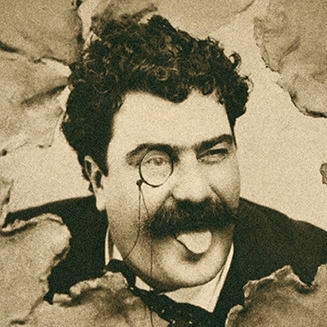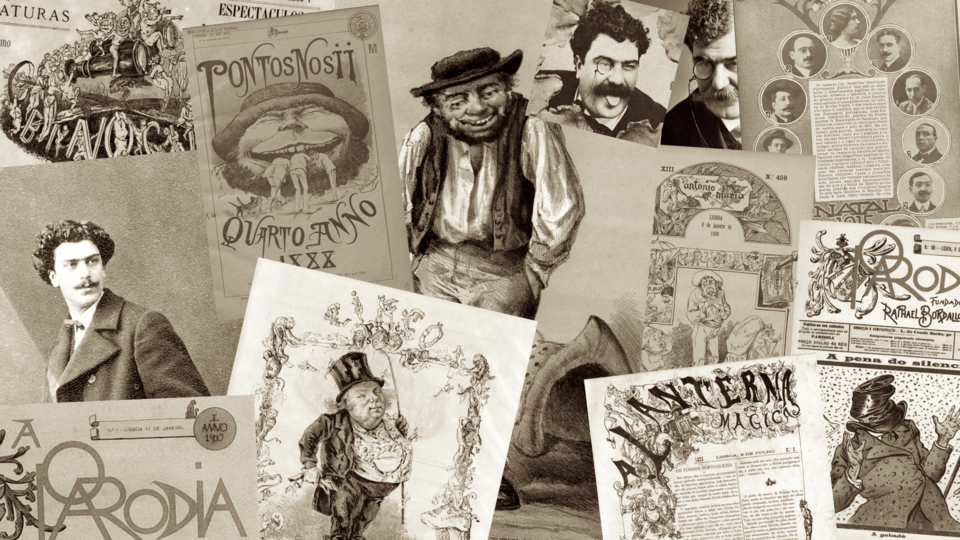The Bordallo Pinheiro family is full of artistic excellence. Raphael and his son are, through their graphic work, the first construction of the designer definition in Portugal.
Raphael Bordallo Pinheiro was born in Lisbon in 1846, into a family connected to the arts, including one of the most renowned Portuguese painters, his brother Columbano Bordallo Pinheiro.

The many faces of Raphael Bordallo Pinheiro
Raphael is mainly recognised for his connection to the graphic arts and ceramics, however, he was a multifaceted artist, linked to the fine arts, object design and decoration.
His work reflects a critique of society, the political and social daily life of the time and, after almost 150 years, his satires are still current today.
Always irreverent, he did not complete his studies but pursued his artistic talents as a self-taught artist. He considered subsisting as a plastic artist, which led him to compete in several exhibitions (winning some prizes), always highlighting popular typology and customs scenes.
His predilection for the popular scene was apparent from an early age, when at the age of just over 10 he made his first drawing, based on a copy of a lithograph depicting a peasant family by the sea.
This demonstrated the strong attachment Raphael felt for man as a social figure.
Bordallo, the first Portuguese caricaturist
What started as a joke to amuse friends, became the main focus of his life and he became the first Portuguese caricaturist. It was with the resounding success of “O dente da Baroneza” and “Calcancanhar de Aquiles” that he realised that his future could indeed lie there.
Lithography was part of his career, composing drawings, caricatures for book covers, illustrated advertisements and almanacks. During this time he collaborated with international magazines, such as, “El mundo comico” (1873-74), “Illustrated London News”, and “Ilustracion Española y Americana” (1873), among others.
It is in 1875 with “A Lanterna Mágica” that he begins a systematic criticism of society, especially of institutions and government.
In this publication appears for the first time the Zé Povinho, a charismatic character representative of the Portuguese people. At this stage, he discovers the power that an artist, a caricaturist has to change opinions and have a greater pedagogical reach in society.

Azevedo, Guilherme de, editor with ; Bordallo Pinheiro, Raphael, illustrator, Newspaper “A Lanterna Mágica”.
He spends a season in Brazil, by invitation, to collaborate in the magazine “O Mosquito” and when he returns to Portugal (1879) he opens his satirical newspaper “O António Maria”, where he intervenes in caricatures and has in part a responsible role in the propagation and rise of republican ideals.
Bordallo Pinheiro Faianças Factory
His activity as a ceramist, which is perhaps the one through which most of us know him, has great relevance when the Faience Factory of Caldas da Rainha was inaugurated together with his brother Feliciano in 1884.
At this stage of his life, Raphael is disappointed with the consequent Portuguese conformism towards the English ultimatum, leading him to be even more critical in his caricatures.
Newspaper “A Paródia”
Then comes the creation of his last newspaper “A Paródia”. Here it is common usage to apply illustrative elements on the front page related to Politics – the big sow, the Finance – the big dog and the Economy – the broody hen.
His son Manuel Gustavo was already one of the main illustrators and it is he, who after the death of his father Raphael, keeps the weekly newspaper and its ceramics alive.

Manuel Gustavo, the pioneer of Portuguese children’s illustration

Like his father, Manuel Gustavo, was an accomplished graphic illustrator, considered a pioneer in children’s illustration in Portugal.
He started at the newspaper “O António Maria”, collaborated in the illustration of technical books, magazines and prominently in the “Ilustração Portugueza”. In addition to all this, he was responsible for drawing several pages of the newspaper “A Paródia” while Raphael devoted much of his time to pottery at the factory.
It was in “A Paródia” that Manuel Gustavo evidenced his graphic characteristics, allied to the Art Nouveau style with recourse to worked friezes and the use of colour.
Manuel Gustavo Bordallo Pinheiro’s new printing techniques
It is also in this weekly newspaper that he innovated with new printing techniques and a publication with the introduction of more colour that allowed him to achieve better sales until it ended in 1907.

Bordallo Pinheiro, Manuel Gustavo, illustrator 1846-1905, Newspaper “A Paródia” (1907)
Both Raphael and Manuel Gustavo had a life dedicated to illustration, to the power that can emanate from a visual image.
Graphic compositions they printed in their satirical newspapers were careful in their choice of details, from the trimmings to the typographical choice.
The newspaper “A Paródia” is an example of a newspaper that was worked to the graphic detail approaching the image of a poster. The work on each front page is remarkable for its care and detail, the stylized lettering is a characteristic of the periodicals designed by Bordallo, showing its illustrative and graphic power.
Chronology of periodical publications:
- O Binóculo; A Berlinda (1870)
- A Lanterna Mágica (1875)
- O Mosquito; Psit!!; O Besouro (1875-1879)
- O António Maria – 1ª série (1879)
- Pontos nos ii (1885)
- O António Maria – 2ª série (1891)
- A Paródia (1900 – 1908)
Learn more about influential Portuguese personalities in the discipline of Design:











